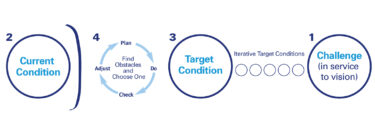Dear Gemba Coach,
Can lean help with the start of production?
Lean, certainly. The real question is: Are engineering teams ready to think lean? Visualize a lean production line: It stops whenever there is an issue, and can only start again when conditions are returned to normal. When Toyota starts a new model, the line stops … all the time. I’m told Toyota actually measures the time it takes to run the line normally at takt time. Plants are compared on how quickly they get to run the line at the planned rhythm.
Concretely, as you start production, you discover three types of issues:
- Performance problems: The final product doesn’t assemble well, or doesn’t pass tests as expected. This is really bad.
- Quality issues: Parts, mostly, are not as good as expected, creating quality problems for final assembly.
- Costs issues: Producing at takt time turns out to be more expensive than anticipated because of the cost of bringing tools and people on board.
If we’re lucky, the issues encountered can be solved by learning to better use the equipment. If we’re not, it requires an engineering change to fix. Engineering changes are slow, costly, and dangerous – you never know what else you impact with a design change.
As a result, lean’s first objective is: zero engineering changes after tooling. This starts way before SOP and needs careful tracking of engineering changes and prototyping to test them. Although it sounds tedious and administrative, the first step to succeeding at SOP is to set up a robust engineering change tracking system.
Start Here
If we take on this challenge – where should we start? There are two things we can look at:
- A clear mechanism to follow supplier drawing concerns: Before the tools are scheduled for production, we need to ask suppliers to share their concerns about part designs and we need a clear format to gather all these concerns and requests and see what can be done or not. Suppliers can be asked to pull the andon cord on any feature that may cause the part to be of poor quality in dimensions, appearance, performance, weight, etc. or that would make it hard to assemble in manufacturing.
- A schedule of tool manufacturing: Not all tools are born equal. Some are easy to modify, some hard. Some need to be extremely precise, some less. Rather than send all tool specs to toolmakers at once, we can think of a pull schedule to have toolmakers work on tools according to lead-times and difficulty. As with supplier design concerns, this schedule can be followed narrowly with regular reports on tool preparation.
For instance, we can start assembling the full product with prototype parts as they arrive in order to see where tolerances matter, where not so much, and have a dialogue with suppliers about where we’re really close to the cliff edge with the exiting process, and where we’re okay.
Once tooling is completed, we can face the two next challenges: 1) 100% parts good and 2) 100% production capacity. To think straight about this we can run two different production trials: Quality trials and capacity trials.
In quality trials, we seek to prove the production method. Every single part is inspected and we look to surface potential problems or improvement opportunities. Here is a Toyota checklist to create the right conditions for the trial:
- Equipment used at final production location
- Machine process parameters defined
- Production operation sequence followed,
- Machine cycle time at mass production rate
- Team members manufacturing parts
- Team leaders and supervisor fully trained
- Standard operations for the machines defined
- Machine capability study completed Cpk > 1.33
- Mass production fixtures used
- Work instructions and quality standards defined
- Data story defined for part manufacture
- Checking fixtures available
Problems such as equipment problems, process or part workability, team members training should all be flagged up to come up with quick countermeasures. The question is: Can we make the part?
A second production trial can then look into volume issues: Can we make the part at the required rhythm? Can we hold quality at peak volumes? This means looking beyond producing parts at the whole manufacturing support system. The Toyota checklist for mass trials becomes:
- Equipment in final location and layout
- Cell cycle time at mass production rate
- Material handling and parts feed system
- MQC fully developed and implemented
- Reject parts flow clearly defined
- All relevant operators trained for one complete shift to manufacture parts
- Capabilities studies completed, Cpk > 1.33
- Fully tuned fixtures used
- Pokayoke devices in place and confirmed
- Representative packaging
- Production monitoring system in place and in operation (Performance Analysis Board)
- Boundary samples in place
- Maintenance plan in place and followed
- Final level checking fixtures available
No Magic
Toyota recommends that every trial should be held for a minimum of one hour and results tracked on the Production Trial sheet.
What lean insights can we learn from these two detailed Toyota checklists for production preparation? That there is no magic in eliminating waste, only serious intent. Visible results are achieved by requisite methods. There is nothing in these lists that is surprising or unexpected – what is, is that Toyota does it. Everyone else knows they should do something like that but then … so many reasons not to.
To prepare a start of production, lean thinking is mostly about goal and method. Our goal is 100% good products at takt time, with zero engineering changes after tooling. Our method is 1) implement simple but consistent exchange formats with suppliers, 2) pull tooling according to risk/difficulty to modify, 3) test that you achieve quality until all parts are good, and 4) test that you achieve production rate until all parts are good at the right cycle time.
Being systematic in how you prepare will allow you to bring the support system to good production up to speed. By front loading the work on conditions this way, you minimize the number of fires that flare up during SOP, and the overall drain of resources this involves.







